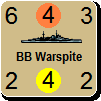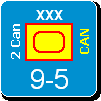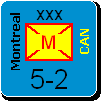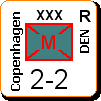warspite1
Posts: 41353
Joined: 2/2/2008
From: England
Status: offline

|
quote:
ORIGINAL: paulderynck
Excellent as usual, however it does not read well chronologically with the between the wars modification info coming before some of the WWI info.
Warspite1
Thanks paulderynck  - please see amended write-up with revised order as suggested. I could not find reference to the incident at Le Havre in the book I have on her; ItBurns can you confirm the source please? - please see amended write-up with revised order as suggested. I could not find reference to the incident at Le Havre in the book I have on her; ItBurns can you confirm the source please?
[4604 Warspite - by Robert Jenkins]
.B Engine(s) output: 80,000 hp
.B Top Speed: 24 knots
.B Main armament: 8 x 15-inch (381mm) guns, 8 x 6-inch (152mm) guns
.B Displacement (full load): 36,096 tons
.B Thickest armour: 13-inches (belt)
.P The Queen Elizabeths were a class of five World War I vintage battleships
that were developed from the Iron Duke class. A sixth ship, Agincourt, was
cancelled before being laid down.
.P For their main armament, they used a new, and as then untested, 15-inch gun
that was to prove a highly successful weapon. They were originally to have five
twin turrets, but by removing the centre turret, additional boilers could be
added to boost speed from 21 to 24 knots. This gave the Royal Navy (RN) the fast,
well armoured battle squadron that it desired and made these ships the most
powerful vessels afloat at their time of launch.
.P HMS Warspite was completed in March 1915 and was destined to become one of the
best known warships in the long, proud history of the RN. She was to earn great
affection within the fleet and at the end of her life, she became known as the
"Old Lady"; although veterans prefer the title "Grand Old Lady".
.P She was a veteran of the fleet encounter at Jutland in 1916. There, she
survived a staggering twenty-nine hits after her steering jammed and she sailed
straight for the German battlefleet. Curiously, the steering malady would never
entirely disappear.
.P The speed of these ships was one of the key factors in ensuring that they
would be suitable for modernisation during the inter-war years; unlike the later
R-class. Three ships, Warspite, Valiant and Queen Elizabeth were substantially
reconstructed in the thirties, but financial and resource constraints meant that
the remaining two ships - Malaya and Barham - failed to receive the same level of
upgrade.
.P Having had bulges fitted to improve underwater protection in the twenties,
Warspite was the first of the class to receive a comprehensive overhaul; the work
taking place between 1934 and 1937. Improvements included the fitting of brand
new, smaller and lighter machinery which increased power and extended her range
by almost double the old figure to over 14,000 miles.
.P The main guns had their elevation increased; so extending their range by 30%
and the 6-inch secondary armament was reduced from twelve to eight guns by the
removal of the fore and aft guns. The anti-aircraft (AA) armament was entirely
new; four twin 4-inch guns and four 8-barrelled 2-pdr pompoms for close-range
cover.
.P Her 13-inch belt armour remained the same, but her weak horizontal armour was
greatly increased, with a maximum thickness of 5.5-inches over the magazines and
3.5-inches over the machinery spaces. This was still not ideal, but at least
offered a measure of protection against air attack.
.P The biggest visual change was the completely new bridge and superstructure, as
a result of which, she was a remarkable vision of new (superstructure) meets old
(hull).
.P The names of the ships of the class had no common theme. Warspite, meaning "to
treat war with contempt" was originally used by the RN during the reign of Queen
Elizabeth I in the 16th Century.
.P At the outbreak of World War II she was deployed with Mediterranean Fleet but
the sinking of the Royal Oak at Scapa Flow, meant that she was ordered back to
the UK to join the Home Fleet. Having arrived at Gibraltar in early November, she
was diverted to Halifax, Canada to assist the escort of a large, homeward bound
convoy, HX.9. On the journey back to the UK she was ordered to detach from HX.9
and join the search for the German battlecruisers Scharnhorst and Gneisenau
following the sinking of the armed merchant cruiser Rawalpindi (see ASW Counter
4698). By the time Warspite arrived off Iceland, the enemy ships had made it back
home (see HMS Newcastle).
.P In December she became Flagship of the Home Fleet and was engaged in convoy
escort and patrol duty in northern waters. She remained in this role until April,
when she returned to the Mediterranean. However, she was recalled to the Home
Fleet in response to the German invasion of Norway.
.P As a result of the RN`s inability to stop the German invasion of Norway (see
HMS Valiant), their main task became helping Allied forces trying to stop the
conquest of the Scandanavian country. It must be remembered that although the RN
had failed to stop the Germans from landing, they and the Fleet Air Arm had
dealt the Kriegsmarine a number of blows during the course of the landings and
shortly after. Brief details are given in the paragraph below below.
.P On the 10th May, Captain Warburton-Lee won the RN`s second V.C of the
Norwegian campaign during a set-piece destroyer action that became known as the
1st Battle of Narvik. Warburton-Lee commanded a force of five destroyers, Hardy,
Havoc, Hostile, Hotspur and Hunter. He led them in darkness through Ofotfjord,
where they attacked a force of ten larger German destroyers. Two enemy
destroyers, Wilhelm Heidkamp and Anton Schmidt, six cargo vessels and the
ammunition ship Rauenfels were sunk for the loss of Hardy and Hunter and severe
damage to Hotspur. This success was followed by Fleet Air arm Skuas, operating at
extreme range sinking the cruiser Konigsberg, and HM Submarines Truant,
Spearfish and Sterlet sinking the cruiser Karlsruhe, damaging the pocket-
battleship Lutzow and sinking the minelayer Brummer respectively. In addition,
numerous transports, tankers and other merchant vessels were sunk by the
submarine service (see Submarine Counter 4736).
.P On the same day as Warburton-Lee`s heroic action, Warspite had joined Admiral
Forbes Home Fleet in the North Sea. Three days later she led a force of nine
destroyers: Bedouin, Cossack, Eskimo, Forester, Foxhound, Hero, Icarus, Kimberley
and Punjabi, into Ofotfjord, the scene of the 1st Narvik battle, to deal with the
surviving eight enemy destroyers. What followed became known as the 2nd Battle of
Narvik. Warspite`s floatplane caught the German submarine, U-64 on the surface
and sank her. Then three RN destroyers turned the Erich Koellner, which was
guarding the entrance to the fjord, into a blazing wreck. The RN ships then
continued into the fjord. Erich Geise met her end at the entrance to the harbour,
followed by the Von Roeder. Next, the Kunne beached herself before blowing up and
the four remaining German vessels retreated into Rombaksfjord, where they were
beached. It was a resounding victory for the RN.
.P Warspite remained off Norway until the end of April, taking part in
bombardment operations in support of efforts to take the port of Narvik. She was
then relieved by the battleship Resolution (see HMS Valiant and HMS Curlew).
.P With the threat of war with Italy looming, Warspite was then transferred back
to the Mediterranean. On the 11th June, as the Flagship of Vice-Admiral
Cunningham, she led the first Mediterranean Fleet sortie after the declaration of
war by Italy the previous day (see HMS Calypso). The following month saw Warspite
taking part in the Battle of Calabria, during which she hit the Italian
battleship Giulio Cesare from 26,000 yards, a record for naval gunnery against a
moving target (see HMS Royal Sovereign).
.P At the end of the month Warspite was again at sea with the fleet, covering
convoys in the Aegean (see HMS Capetown). On the 17th August, Warspite took part
in the bombardment of Italian positions at Bardia and Fort Capuzzo, Libya (see
HMS Malaya). Her next operation was HATS at the end of that month. This was an
operation to re-supply Malta and get reinforcements to the Mediterranean Fleet
(see HMS Calcutta).
.P At the end of September Warspite covered the cruisers Liverpool and Gloucester
as they delivered troops to Malta (see HMS Liverpool). She was then deployed with
the fleet as distant cover for convoys MF3 and MF4 (see HMS Calcutta). Warspite
took part in fleet operations in the Eastern Mediterranean in November (see HMS
Malaya) and later that month she was involved in Operation MB9 (see HMS
Despatch). The last month of the year saw Warspite involved in Operation MC2 (see
HMS Malaya) during which she and Valiant bombarded the Albanian port of Valona.
.P The New Year saw Warspite take part in the second bombardment of Bardia (see
HMS Terror) quickly followed by the important Operation Excess (see HMS
Southampton), during which she was very lightly damaged in an attack by the newly
arrived, crack German anti-shipping force, Fliegerkorps X. Following this, in
March Warspite covered the Lustre convoys that took the ill-fated Commonwealth
Expeditionary Force to Greece, and she also covered convoy MW6 to Malta (see HMS
Bonaventure). At the end of the month she played a key role in the successful
Battle of Cape Matapan that saw the sinking of three Italian heavy cruisers and
damage to the battleship Vittorio Veneto (see HMS Barham).
.P The following month, Warspite took part in covering two convoy operations (see
HMS Ajax) that included a shore bombardment mission against Tripoli. At the start
of May, Warspite was part of a complex operation that involved the sailing of the
famous Tiger convoy through the Mediterranean to Egypt (see Transport Counter
4729) and two convoys being sent to Malta from Alexandria. The Mediterranean
Fleet covered the latter two convoys and then the Tiger convoy once it had passed
Malta.
.P Warspite was sent to Crete in mid-May to cover the cruiser and destroyer
forces patrolling the island in an effort to stop the Germans reinforcing their
earlier airborne landings by sea (see HMS Fiji). During this action, Warspite`s
luck finally ran out. A force of three Messerschmitt 109`s in a fighter-bomber
role, attacked her west of the Kithera Channel and she was hit by a bomb which
caused extensive damage. Warspite returned to Alexandria for temporary repair
followed by permanent repairs in the USA.
.P The repair work was completed in December and in March 1942 she was ready to
take up duty as the Flagship of the 3rd Battle Squadron, Eastern Fleet in
company with the four remaining elderly R-class battleships. Warspite survived
Vice-Admiral Nagumo`s Indian Ocean raid in April due to the Eastern Fleet failing
to find the Japanese fleet (see HMS Cornwall). Two months later, following the
Battle of Midway, with four of Nagumo`s carriers at the bottom of the Pacific,
the Indian Ocean theatre suddenly became relatively quiet. The remaining months
of Warspite`s duty there was limited largely to convoy defence and she took part
in Operation Stab (see HMS Mauritius), a diversionary exercise in the Indian
Ocean. Before leaving the region, Warspite took part in Operation Stream (see
HMNZS Gambia), the operation to complete the conquest of the Vichy held island of
Madagascar.
.P In March Warspite returned to the UK for a refit and on completion she was
sent to the Mediterranean, where she arrived in mid-June. In July, she assisted
the landings on Sicily (see HMS Cleopatra) and the follow-up operations to
secure the island (see HMS Howe). Warspite remained in the Mediterranean to
assist the landings against mainland Italy at the end of August (see HMS Erebus)
and then in September, she covered the Allied landings at Salerno (see HMS
Abercrombie and HMCS Uganda). Whilst off Salerno on the 16th, she was badly
damaged when hit during a Glider Bomb attack. This resulted in severe flooding
and she had to withdraw from the action. There was a very real possibility that
she would not survive, but heroic efforts by her crew saw her eventually reach
Grand Harbour, Malta. After repair work in Malta and then Gibraltar, Warspite
returned to the UK. Because of other priorities, she was not fully repaired and
only had the use of three of her main turrets for the remainder of the war.
.P In June, Warspite provided support for the Allied landings in Normandy - D-Day
- as part of Bombarding Force D, Eastern Task Force (see HMS Ramillies). Two days
after the initial assault she was transferred to the Western Task Force area,
providing support off Utah Beach. She briefly returned to her original position
before returning to the UK for replenishment and to make good damage caused by
the incessant firing of her own guns. While en route home, she detonated a mine
that caused additional damage, although she was able to continue to port. Partial
repairs were carried out, but she was only able to achieve a speed of 15 knots
thereafter. Given that she was to be used for shore bombardment only this was not
an issue and after receiving a new outfit of 15-inch guns, Warspite returned to
Normandy in mid-August, remaining there until October.
.P Warspite`s last contribution in the Second World War took place in support of
the assault on Walcheren Island, Belgium. Here, along with the monitors Erebus
and Roberts, she bombarded the enemy shore batteries with three hundred and fifty
-three shells. Just before 0530hrs on 1st November 1944, her six remaining
serviceable 15-inch guns opened up for the last time. Warspite was then withdrawn
from service and placed in Reserve.
.P HMS Warspite was due to be scrapped in 1947. Despite protests that she should
be saved as a museum ship, she was destined for the breakers. Even then the Old
Lady had other ideas and whilst on route to the breaker’s yard, she ran aground
off Cornwall. Sadly, even Warspite could not cheat the end although her break-up
was not completed until 1956.
_____________________________
England expects that every man will do his duty. Horatio Nelson October 1805  |
 Printable Version
Printable Version








 - please see amended write-up with revised order as suggested. I could not find reference to the incident at Le Havre in the book I have on her; ItBurns can you confirm the source please?
- please see amended write-up with revised order as suggested. I could not find reference to the incident at Le Havre in the book I have on her; ItBurns can you confirm the source please?  .
. 



 . Oh well I`ll just have to keep digging.......
. Oh well I`ll just have to keep digging....... 
 New Messages
New Messages No New Messages
No New Messages Hot Topic w/ New Messages
Hot Topic w/ New Messages Hot Topic w/o New Messages
Hot Topic w/o New Messages Locked w/ New Messages
Locked w/ New Messages Locked w/o New Messages
Locked w/o New Messages Post New Thread
Post New Thread